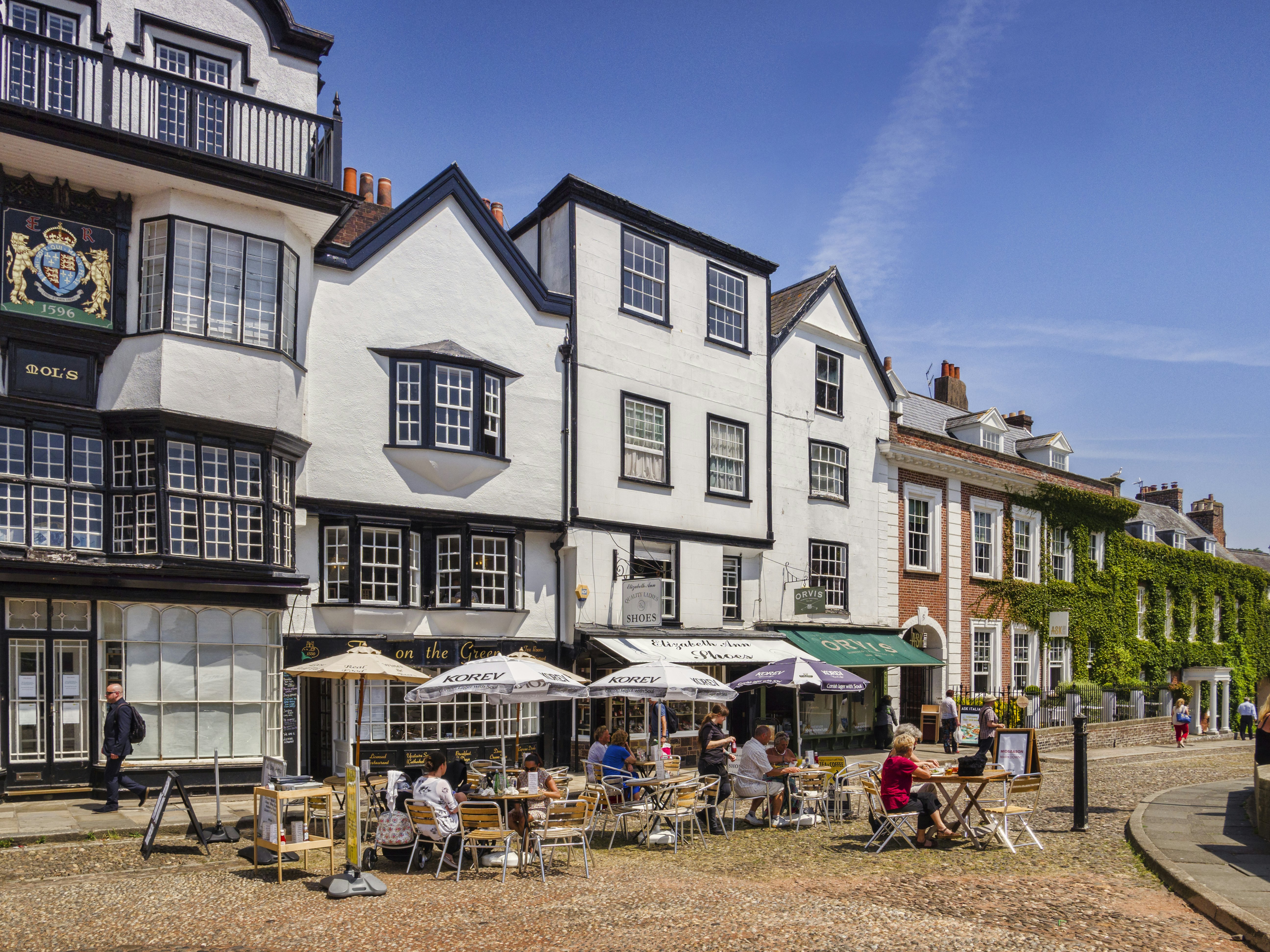Set in the heart of Devon in the holiday haven of Southwest England, Exeter pulses with history, culture and vibrant energy, thanks partly to its sizeable student population. Founded 2000 years ago by the Romans, this is a city that blends modern vim with history on every corner.
Traces of the town’s Roman walls still stand, alongside sections of a Norman castle, a monumental cathedral, a medieval guildhall and a profusion of gabled Tudor architecture. Exeter has lived many historical lives, leaving behind an attractive, eclectic old center, where the city’s rich past comes alive.
Exeter is today a lively university town with buzzy nightlife, a vibrant arts scene and a plethora of independent shops and locally-run businesses, while once-busy Exeter Quay has been reinvented as a riverside leisure hub.
Advertisement
Whether you choose to spend your time wandering among beautiful buildings and antique shops in the city’s medieval heart, or use Exeter as a launching point to explore the beaches and coastal towns of England’s scenic southwest, here are the top things to do in Exeter to fill out your itinerary.

1. Climb the towers of Exeter Cathedral
Stretching high above the rooftops, Exeter’s grand cathedral, officially known as the Cathedral Church of St Peter, is one of Devon’s most impressive sights. Built by the Normans on the site of a Saxon Abbey in 1114, but rebuilt and expanded during the 13th and 14th centuries, the cathedral’s blend of architectural styles mirrors Exeter’s long and varied history, and it deserves lengthy exploration.
Beyond the exquisite fan-vaulted ceiling, the dazzling jewel in the cathedral’s crown is the elaborate West Front Image Screen, covered with myriad carved figures depicting angels, kings, lords and saints. Created in the 14th century, this masterpiece of medieval creativity was once brightly colored – you can still see traces of red behind some of the figures today.
To climb to the rooftop and ascend the cathedral’s Norman towers, you’ll need to join a tour – these operate on fixed dates, visiting behind-the-scenes parts of the cathedral, and you can book online, but be ready to climb lots of steps.
Planning tip: From mid-November to mid-December, the open space surrounding the cathedral hosts Exeter’s biggest Christmas market, coinciding with special Christmas services and carol performances.
2. Explore the cobbled paths of the historic Quayside
Once a vital thoroughfare for shipping, industry and trade in the city, the River Exe today has a sleepier feel, bringing a hint of the Devon countryside into the city. The revamped Exeter Quayside zone buzzes on sunny days, with plenty of options for alfresco dining and drinking.
A short walk or cycle south will deliver you to the tranquil surroundings of the parks and meadows that line the river and the Exeter Ship Canal, which runs alongside the Exe to Topsham. To escape the city by water, rent a kayak, canoe or paddleboard from Kayakhub Exeter and set off on a leisurely journey downriver.
Detour: Feeling peckish on the Quayside? Grab a bite at On the Waterfront, a cool waterfront restaurant and bar known for its tapas, pizzas and cocktails.

3. Squeeze into Exeter’s spooky Underground Passages
Prepare to don a hard hat, squeeze into cramped spaces and get the odd scare on a tour of Exeter’s Underground Passages, a system of 14th-century vaulted tunnels built to bring clean drinking water into the city using medieval lead pipework.
Advertisement
After you enter from Paris St, guides will lead you on a scramble through narrow and claustrophobia-inducing passageways, sharing tales of ghosts, escape routes and cholera outbreaks, with the unnerving rumble of traffic overhead.
Detour: You can explore the waterways above ground on a cruise along the Exeter Ship Canal and River Exe with Stuart Line Cruises. Trips run all the way to Exmouth, and you can return to Exeter by public transport. Shorter boat tours run by Exeter Cruises go as far as the Double Locks pub.
4. Discover local history on a free Redcoat Tour
To learn more about the city’s rich history, dive into Exeter’s many past lives with a local expert. Run by the City Council, Redcoat Tours offers a diverse, year-round program of funny, fascinating and free tours of Exeter led by passionate locals clad in bright red blazers.
These guided tours usually last 90 minutes, covering everything from the city’s Roman origins and historic architecture to ghosts and local legends. For a solid overview of local history, start with their “Heart of Exeter” or “Introducing Exeter” tours. Most tours depart from Cathedral Green and no advance booking is required.
Planning tip: Periodically, the Redcoat team runs special themed tours to tie in with specific events, including popular ghost tours at Halloween.

5. Tour the collections at the Royal Albert Memorial Museum
A fixture on the city’s cultural scene since Victorian times, this hulking red-brick museum, popularly known by its acronym, RAMM, is a treasure trove of rambling rooms. It’s free to enter, and the museum’s glass display cases are stuffed with curiosities and archaeological finds.
With over one million objects displayed across 16 galleries, and plenty of family-friendly activities, it’s easy to spend much of the day here. Highlights range from remarkable samurai armor, African masks and Egyptian mummies in the World Cultures galleries to a truly amazing echinoderm collection, featuring starfish and sea urchins from across the globe.
The museum’s 8000-strong fine art collection is also impressive. Look out for works by Thomas Gainsborough, Sir Joshua Reynolds, Stanhope Forbes and Barbara Hepworth.
Detour: Just a minute’s walk from RAMM, the Exeter Phoenix art center on Gandy Street is an imaginative creative hub in the heart of the city, supporting and showcasing local talent with free-to-visit visual art galleries, special exhibitions and cultural events.
6. Wander the charming Rougemont Gardens
Surrounding the remains of Exeter Castle – also known as Rougemont Castle, and now a popular wedding venue – the Rougemont Gardens offer a peaceful escape that seamlessly blends history and nature. Originally part of the castle’s defenses, the gardens were planted in the late 18th century, preserving historic sections of the city’s Roman walls.
Locals and visitors gather to stroll around the vibrant beds of plants and flowers, play in the tennis courts, let kids burn off energy in the play area, or stop for a picnic or a snack in the small café.
Detour: Set aside some time to peek at the castle’s ruined Norman gateway – its red stone gave Rougemont Castle its name. For more castle action, head to stately Powderham Castle, about 7 miles from Exeter; founded in 1391, it’s renowned for its wood-panelled Great Hall.

7. Eat and drink the Exeter Way
Exeter has a busy drinking and dining scene, making good use of the seafood hauled in from the waters around the mouth of the River Exe. For quality food full of seasonal, local ingredients, head to Harry’s Restaurant, set in a striking 19th-century building on Longbrook St. After dinner, have a drink at the Old Firehouse, a friendly cider and ale-lovers pub near the cathedral.
Creative cooking and sleek presentation define the menu at cool Stage on Magdalen St, or swing by the agreeably informal Eat on the Green by the Cathedral Green for big breakfasts, fish and chips, burgers with fun toppings and more. South of the center, where the River Exe widens at Topsham, Galley Fish & Seafood Restaurant serves quality seafood sourced fresh from Devon’s fishing boats.
8. Visit the alternative hub of Totnes
At the top of the Dart Estuary, a 30-minute train ride from Exeter, Totnes is a charming market town, packed with historic buildings and fine Tudor architecture but best known for its hippy leanings and alternative vibe.
In 2011, Totnes officially became a Fairtrade Town, and Riverford Farm, the birthplace of the famous organic veggie-box subscription service, lies nearby. Totnes High St continues to be one of the most free-spirited shopping strips in England, crammed with zero-waste shops, local crafts boutiques and vegan cafes.
Historic highlights include Totnes Castle, a Norman motte and bailey castle with a 13th-century stone keep, the colonnaded Tudor buildings near the top of the High St, and the ancient Guildhall tucked away down a leafy side street behind the church. Learn more about local history at the Totnes Museum, with its cute Elizabethan Garden, and the Totnes Fashion and Textiles Museum.
Detour: When hunger calls, enjoy eco-friendly, farm-to-table cooking at Riverford Field Kitchen or stop in at the ethically-run Bull Inn pub for healthy, locally sourced organic food, wines and ales.
This article was adapted from Lonely Planet’s Great Britain guidebook, published in July 2023.

